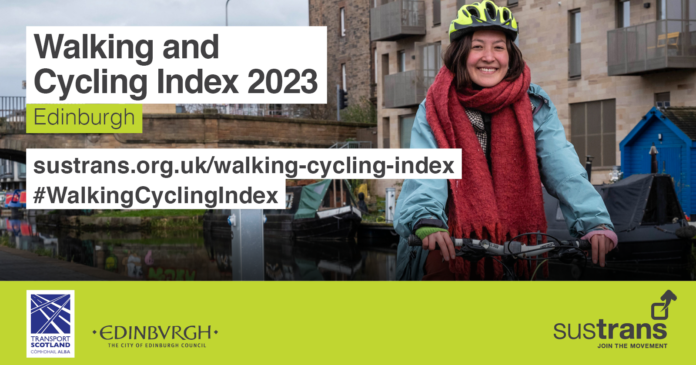Half of Edinburgh residents want to see more spent on walking, wheeling and cycling improvements across the city, according to a new report.
The biannual Walking and Cycling Index, delivered in partnership between Sustrans and the City of Edinburgh Council, draws on independent survey feedback from a cross-section of more than 1,200 residents in the Capital, surveyed in 2023. Today Sustrans joined the City of Edinburgh Council to officially launch the Index with a panel discussion on access to walking, wheeling cycling in the city.
Amongst the findings, the report shows that 50% would like to see more spent on cycling while 57% want investment in walking and wheeling and 68% support an increase in spend on public transport. Almost half of residents want to walk and wheel (45%) and cycle (49%) more too, along with a quarter who want to use public transport more, and improved infrastructure is key to this.
Regular walking and wheeling remains as high as 2021, with two-thirds of people travelling by foot or wheel five days a week. The annual number of cycling trips has increased to 30.7 million from 24.4 million in 2021, although the number of residents cycling at least once a week dropped slightly from 26% to 22%.
The majority of residents think their local areas could be improved through a 20-minute neighbourhood approach – with more and easier to access shops and everyday services (say 79%) and parks and greenspaces close to home (according to 78%) amongst the incentives to walking and wheeling more. Sixty-nine per cent agree they can already get to many places they need to visit without having to drive.
Councillor Scott Arthur, Transport and Environment ConvenerAs ever, the Walking and Cycling Index makes an extremely interesting read, and it’s thanks to the many people from all parts of the city who took part in the survey last year.
Edinburgh is a compact, walkable city, as demonstrated by the many people who already regularly walk, wheel and cycle here. However, what’s clear from the Index is that there’s still much to be done to encourage even more people make the shift to travel on foot, wheel, bike or, in some cases, public transport.
Thankfully, we’re on the right track, with an ambitious programme of development underway which will transform the way people travel around the city, and the results of the Walking and Cycling Index reassure us that we have the backing of Edinburgh’s residents to invest in these kinds of changes.
The majority of residents think local areas could be improved through a 20-minute neighbourhood approach, and we will consult on this approach via our proposals to make Dalry greener, healthier and more vibrant.
From our recent ban on pavement parking to the completion of the City Centre West to East Link, as well as longer term plans like the tram line between Granton and the BioQuarter and City Centre Transformation, we’re working to make Edinburgh a truly people-friendly city.
Karen McGregor, Director, Sustrans ScotlandI’d like to thank the people of Edinburgh who gave us their time to take part in the Walking and Cycling Index. The results show that making walking, wheeling and cycling the most accessible and desirable form of transport is of great importance to people, especially during the current cost of living crisis.
There is clear evidence that people in Scotland’s capital want the option to walk, wheel and cycle to where they need to get to more often. The recent ban on pavement parking in the city is a huge step forward, but the Index also shows that people living in Edinburgh want safe, accessible cycle paths and pedestrian crossings; and they want more investment in public transport.
The latest Index results show that The City of Edinburgh Council has the backing of the public to build on the work it has already started to make it easier for people to walk, wheel and cycle to get around.
Other findings in the Index include inequalities and varied perceptions of walking, wheeling and cycling amongst different groups. Twenty-eight per cent of men cycle at least once a week compared to 16% of women, while the proportion of white residents who walk or wheel at least five days a week (67%) is higher than people from ethnic minority groups (55%).
Participants in the survey shared their views on the kinds of improvements that would encourage them to walk, wheel and cycle more. Some of the changes that would encourage people to travel by foot or wheel are fewer cars parked on pavements (67%), nicer places on streets to stop and rest (71%) and wider pavements (68%).
Seventy-three per cent said more traffic-free cycle paths away from roads and 65% highlighted segregated cycle paths on roads as improvements that would help them to cycle more, while 58% support building more cycle paths physically separated from traffic and pedestrians, even when this would mean less room for other road traffic.
The report also emphasises the benefits already being delivered by people walking, wheeling and cycling in the Capital. By taking up to 160,000 cars off the road every day, each year they help prevent 1,314 serious long-term health conditions, create £262.6 million in economic benefits and save 42,000 tonnes of greenhouse gas emissions.
Read the full Edinburgh Walking and Cycling Index 2023 report.


